Frost-resistant honeysuckle variety Violet
Violet is a medium-ripening variety of edible honeysuckle. It has many positive characteristics, among which special mention is made of frost resistance, ease of care, pleasant taste of the fruit and high content of ascorbic acid. In the article we will talk in detail about these and other advantages of the variety, its disadvantages and agrotechnical requirements.
Honeysuckle Violet: variety description
This is one of the most popular domestic varieties of edible honeysuckle. 100 g of Violet berries contain 45 mg of vitamin C and 637.2 mg of P-active substances. They are useful for anemia and sore throat, help strengthen the immune system and prevent the formation of tumors, and have anti-inflammatory and antibacterial properties.
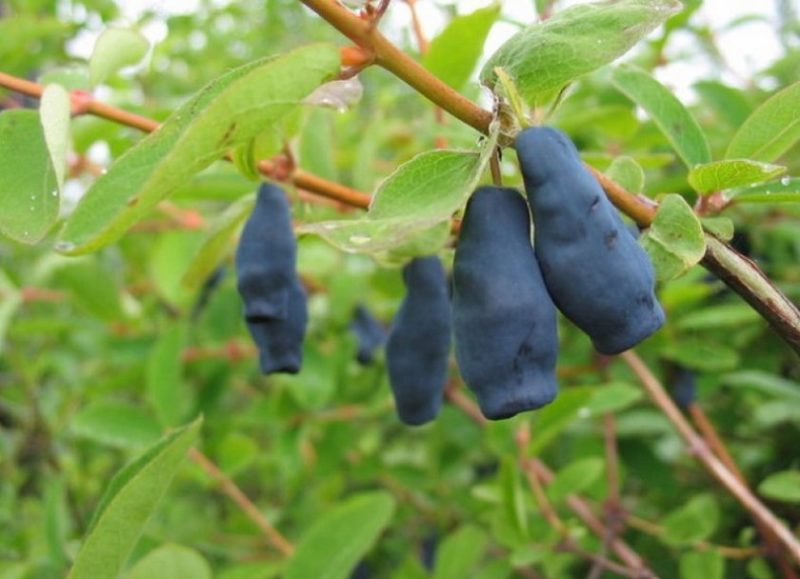
Origin and development
Honeysuckle Violet was bred by breeders of the Pavlovsk experimental station VIR (St. Petersburg) as a result of free pollination of the Roxana variety. Later it was tested in Ukraine at the Krasnokutsk experimental station.
The authors of the variety are N. M. Plekhanova, A. V. Kondrikova, V. A. Kikbalo. Included in the State Register of Agricultural Crops of Russia in 1995, first in the North-West region, then in all zones of crop cultivation.
Description of appearance, taste
The plant is a medium-sized, slightly spreading bush 1.3-1.5 m high with a dense spherical crown and thickened, straight, pubescent shoots of a brown-green color.
The leaves are large, flat, oval, bright green in color.Flowers with a maximum diameter of 2 cm, at first pale green, become creamy white over time, collected in inflorescences of 2 pieces.
The flowering period lasts until the end of May, after which berries weighing 1.14-1.5 g appear on the bushes. Fruits with a slightly bumpy surface, elongated, pitcher-shaped, reach a length of 2.8-3 cm and a thickness of no more than 1.2 cm, covered with a thin but strong blue-violet skin with a light waxy coating.
The pulp is fibrous, dense, characterized by a light pleasant aroma and sweet and sour taste.
In the photo - blue honeysuckle Violet.
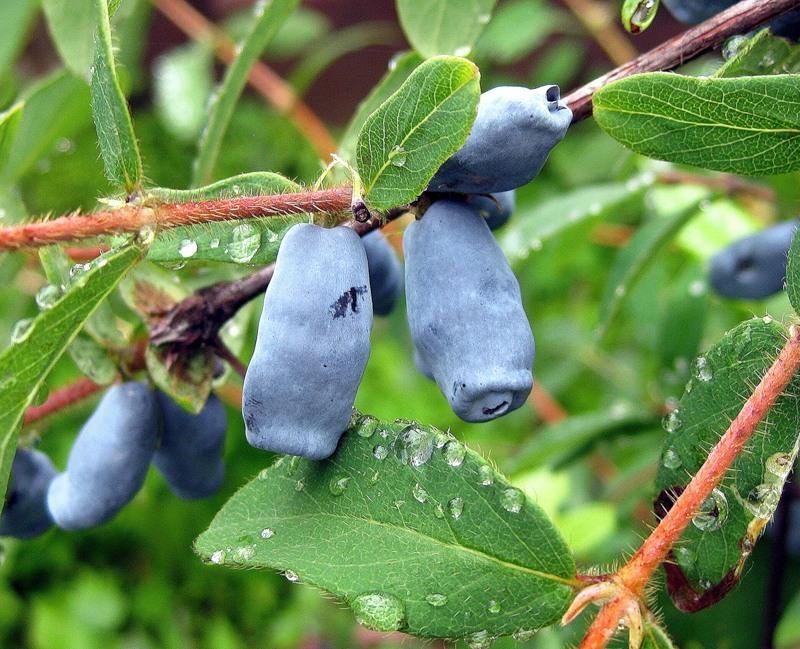
Ripening period, yield and fruiting
This is a mid-season variety of honeysuckle - the harvest ripens at the end of May (in Ukraine) or June (in the Moscow region). The bushes begin to bear fruit 3-4 years after planting, the average yield is up to 1.8 kg per bush or 51 c/ha.
Resistance to diseases and pests
Violet has good immunity to diseases and pests, but violation of agrotechnical requirements can lead to attacks by aphids, scale insects, mites, leaf rollers, miners, Persian moths, sawflies and bedbugs. Unfavorable weather conditions (heavy rains, sharp drops in air temperature) provoke the development of fungal diseases, in particular powdery mildew.
Resistance to cold and drought
The bushes can withstand air temperatures dropping to -12…-15°C. Plants can tolerate short-term drought, but the soil should not be allowed to dry out completely. Waterlogging of the soil is also unacceptable - increased humidity provokes rotting of the roots and the development of fungal diseases.
Suitable regions
Honeysuckle Violet tolerates frost well, does not have any special requirements for climate and soil composition, and is therefore suitable for cultivation in all regions.
Advantages and disadvantages of the variety
The main advantages of Violet:
- excellent berry taste;
- high vitamin C content;
- good transportability and keeping quality;
- possibility of universal use of fruits;
- resistance to cold, many diseases and pests;
- decorative appearance of bushes;
- unpretentiousness;
- no tendency to shed berries.
The disadvantages of the variety include the need for good lighting and self-sterility.
Honeysuckle Violet: difference from other varieties and hybrids
A comparison of Violet with other mid-season honeysuckle varieties is presented in the table.
| Variety | Average weight of berries, g | Taste | Berry color | Productivity, kg/bush |
| Violet | 1,14-1,5 | Sweet and sour | Blue-violet | 1,8 |
| Bakchar giant | 2,5 | Sweet and sour | Violet | 5 |
| Berel | 0,4-1 | Sourish-sweet with tartness | Dark blue | 3-4 |
| Vasyuganskaya | 0,8 | Sweet and sour without bitterness | Dark purple | 1,5-2,5 |
Agricultural technology
Honeysuckle Violet is an unpretentious plant that does not have any special care requirements. The main thing that is important to consider when planting it on a plot is the need to plant it near pollinating varieties.
Choosing a place in the garden and preparing holes
To plant this variety, choose a well-lit place, since the lack of light negatively affects the yield: fewer berries are formed, they grow small and sour. The permissible depth of groundwater is at least 1.5 m.
Preparing for landing
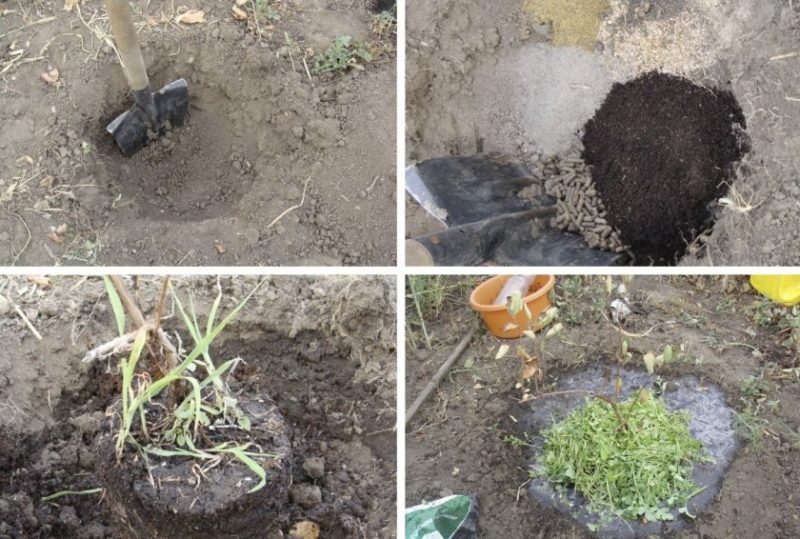
Planting holes with a diameter of 50 cm and a depth of 30-40 cm in the selected area are dug 2-3 weeks before planting. The top layer of excavated soil is mixed with organic (peat, humus, rotted manure) and potassium-phosphorus fertilizers and half of the hole is filled with the resulting soil mixture. Lime is added to acidified soil, and coarse sand and ash are added to heavy soil.
Seedlings are purchased from specialized nurseries, giving preference to 2-year-old specimens 30-40 cm high with 2-3 branches with buds, a moist root system without signs of rot, damage, or disease.
Soil requirements
Honeysuckle Violet grows well in light, loose, fertile soil with good aeration, moisture permeability and neutral acidity.
Dates, scheme and rules of planting
Depending on the climatic conditions of the region, planting is carried out from late August to early November. In spring, they try not to plant honeysuckle due to early sap flow.
Reference. Seedlings with a closed root system can be planted throughout the growing season.
Landing rules:
- Pour boiling water over the prepared planting holes.
- Place the seedling in the center of the hole, cover it with soil so that the root collar is buried a maximum of 3-5 cm.
- Compact the soil, water the plantings, and mulch the soil with a layer of straw.
The distance between bushes should be at least 1 m, between rows - 2 m.
Honeysuckle violet: growing features
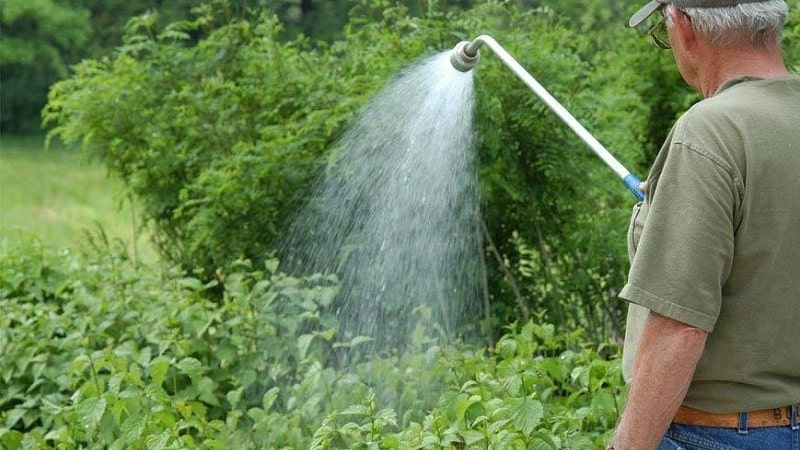
The frequency and abundance of watering depend on the climate and weather conditions of the growing region. During dry periods, the bushes are watered several times a week at the rate of 10 liters of water for each plant. During rains, the procedure is stopped.
Reference. Every year, a solution is poured under each bush to reduce the acidity of the soil - 1 kg of ash per bucket of water.
After watering, the soil is loosened to improve its moisture and breathability, and weeded to remove weeds. Mulch is used to protect the soil from drying out and weeds.
They begin to feed Violet from the 3rd year after planting. Fertilizers are applied according to the following scheme:
- in early spring - nitrogen-containing, promoting the growth of green mass (for example, 1 tablespoon of urea per 10 liters of water);
- in May - organic fertilizing (humus, rotted manure or bird droppings - 1 bucket for each bush);
- in autumn - organic fertilizers (0.5 buckets of humus and 40 g of superphosphate).
During the autumn period, sanitary pruning: remove all dry, damaged and growing shoots. Crown formation begins when the bushes reach 6 years of age.
After this, rejuvenating pruning is performed every 2-3 years, removing not only dry and damaged shoots, but also lower shoots that do not bear fruit, leaving about 5 main branches.
Shortening seedlings leads to delayed fruiting.
Pollinators
This is a self-sterile variety of honeysuckle: cross-pollination is necessary for the bushes to bear fruit. The most suitable pollinator varieties for Violet are: Amphora, Viola, Blue Spindle, Morena, Nymph.
Disease and pest control
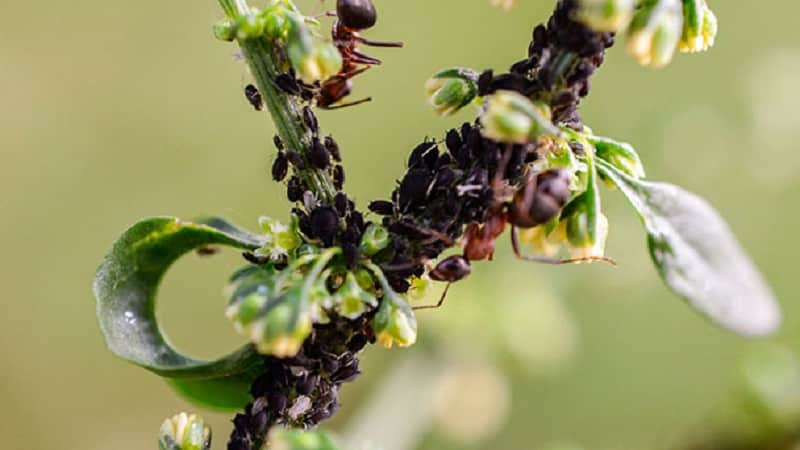
Diseases and pests that can affect Violet are presented in the table.
| Disease/pest | Signs | Treatment/prevention |
| Aphid | Leaves turn yellow and fall off. | To control pests, bushes are treated with Fitoverm, Lepidotsid and Karbofos. To prevent their appearance in early spring, use the preparations “Confidor”, “Decis” or “Aktara”; during the ripening of the fruits - a tobacco-soap solution, onion or garlic infusion. |
| Shchitovka | ||
| Ticks | ||
| Leafrollers | The leaves curl and holes appear in them, which insects gnaw through. | |
| Miners | ||
| Persian moths | ||
| Sawflies | ||
| Bedbugs | ||
| fingerwings | The berries wrinkle and fall off. | |
| Powdery mildew | A white powdery coating appears on the leaves. | The bushes are treated with copper-containing preparations ("HOM") or "Fitosporin". As a preventative measure, bushes are sprayed with Bordeaux mixture or copper sulfate, and all fallen leaves and cut shoots are burned. |
Preparing for winter
Due to its high degree of frost resistance, Violet honeysuckle does not require winter shelter.
At the end of autumn, the plants and soil are cleared of fallen leaves and other plant debris, hilled up, and the tree trunk circle is mulched with straw. The bushes are covered with a dense net to protect the buds from birds.
Difficulties in growing
When growing honeysuckle Violet, you may encounter the following problems:
- low yield, sour berries - the bushes probably grow in the shade and lack light;
- white powdery coating on leaves and shoots is a sign of powdery mildew, which develops as a result of heavy rains or when growing honeysuckle in marshy soil.
Reproduction
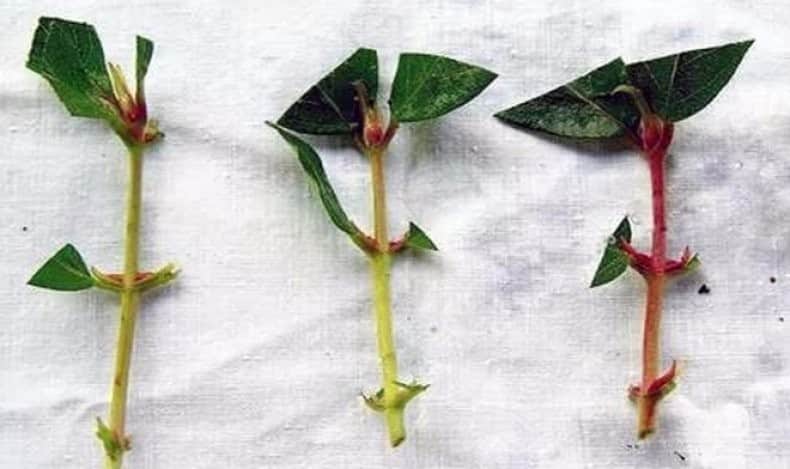
Most often this variety is propagated cuttings. To do this, immediately after the first green fruit ovaries appear, the green shoots of the current year are cut into pieces no longer than 15 cm. This should be the middle part of the branch with a pair of leaves. The cut at the top should be straight, at the bottom - at an angle of 45°.
The cuttings are planted in a peat-sand mixture (proportions 1:3), the containers are covered with polyethylene to create a greenhouse effect and kept at an air temperature of +20...+22°C and a humidity of 85%. 10 days later, after the roots appear, the cover is removed. Plants are planted in the ground in the spring, covered with spruce branches until the weather warms up.
You can also propagate plants:
- Dividing the bush. In the off-season, an overgrown bush with adventitious roots is dug up, divided into parts and each planted as an independent seedling.
- By layering.Annual shoots growing with an inclination to the ground are bent to the ground in the spring, their tops are pinched and dug in, and in the fall, after the root system has formed, they are separated from the mother bush and planted in a permanent place.
Harvest and storage
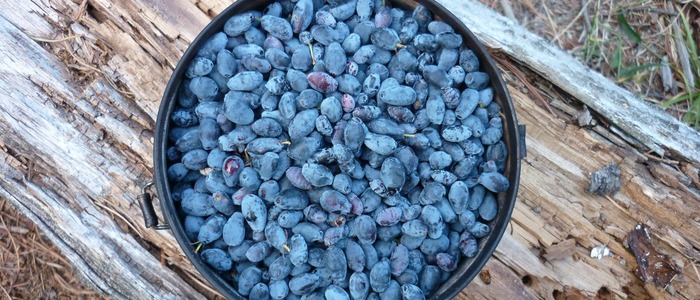
The berries are starting to be picked at the end of May. They appear on side branches, inside bushes and mature unevenly - first from above, then from below. The fruits are picked as they ripen and stored in the refrigerator for a maximum of 2-3 days.
Honeysuckle Violet is suitable for fresh consumption, freezing, drying, making juices, compotes, wine, jam.
Tips and reviews from experienced gardeners
Gardeners recommend:
- carefully choose a place for planting - the bushes grow and bear fruit for up to 25 years in one place, there should be a lot of light;
- do not neglect preventive treatments - despite the good immunity of the variety, diseases and pests can still affect it;
- monitor the ripening of the crop - the berries are prone to shedding.
They respond positively to Violet honeysuckle.
Sergey, Moscow region: “I didn’t like honeysuckle right away, but when I tried these berries, I decided to plant them on my plot. The choice fell on Violet, since it was stated that she was unpretentious in care. This is actually true. All care - Water several times and trim the bushes. Berries with a rich, bright taste, more sweet than sour.”
Elena, Ryazan region: “Previously, we always bought honeysuckle at the market, but when the plot appeared, we decided to grow it ourselves. We chose violet by chance; we didn’t read or hear any reviews about this variety, but in the end we don’t regret it. We were immediately warned that she needed pollinators, so along with Violet seedlings we also bought Viola and Amphora.The bushes bear fruit consistently, the yield is quite high, the berries are tasty both fresh and as jam.”
Conclusion
Violet is a mid-early honeysuckle variety of domestic selection, which is characterized by a pleasant sweet and sour taste of berries, good transportability, frost resistance, immunity to many diseases and pests and unpretentiousness. Along with so many positive characteristics, the variety has only a few disadvantages: the need for lighting and pollinating varieties.